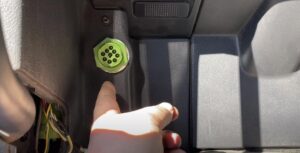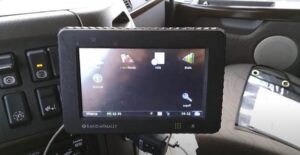
Here at DriveELD, we have found that drivers are often unsure of what type of diagnostic port their truck has. There are a few ways to find out that we wanted to show you. First, there are three main types of diagnostic ports, 6-pin (J1708), 9-pin (J1939), and OBDII’s. Generally, light and medium-duty trucks use OBDII ports whereas heavy-duty trucks use 6-pin or 9-pin ports. Volvo and Mack trucks with OBDII ports use a different, more heavy-duty cable.
The DriveELD package comes with a cable that connects the device to 9-pin (J1939) ports.
Diagnostic ports are generally located below the steering wheel on the left side. See common locations marked on the graphic.
Your truck’s engine type can also be used to find your diagnostic port. Below is a guide on how that works.
Vehicle Diagnostic Port Guide
| Make/Type | Year | Engine | Diagnostic Port |
| Freightliner | 2005 & older | All | 6-pin |
| 2006–2015 | All | 9-pin | |
| 2015 & newer* | All | 9-pin Type II (green) | |
| Kenworth | 2005 & older | All | 6-pin |
| 2005–2015 | All | 9-pin | |
| 2015 & newer* | All | 9-pin Type II (green) | |
| Peterbilt | 2005 & older | All | 6-pin |
| 2006–2015 | All | 9-pin | |
| 2015 & newer** | All | 9-pin Type II (green) | |
| International | 2006 & older | Cummins | 6-pin |
| 2006–2015 | Cummins | 9-pin | |
| 2005 & older | CAT | 6-pin | |
| 2005–2014 | CAT | 9-pin | |
| 2015 & newer* | All | 9-pin Type II (green) | |
| Volvo | 2000 & older | Volvo | 6-pin |
| 2001–2014 | Volvo | 9-pin | |
| 2014 & newer | Volvo | OBDII Plug (16-pin) | |
| 2006–2016 | Cummins | 9-pin | |
| 2016 & newer* | Cummins | 9-pin Type II (green) | |
| Mack | 2000 & older | Volvo | 6-pin |
| 2001–2014 | Volvo | 9-pin | |
| 2014 & newer | Volvo | OBDII Plug (16-pin) | |
| Western Star | 2006–2016 | Cummins | 9-pin |
| 2016 & newer* | Cummins | 9-pin Type II (green) | |
| 2010–2015 | All | 9-pin | |
| 2015 & newer* | All | 9-pin | |
| Light/Medium Duty Vehicle | 2008 & newer | All Diesel and Gas | OBDII Plug (16-pin) |
*Ensure that the diagnostics port on your truck does have a 9-pin connection
**Peterbilt and International trucks manufactored from 2017-2018 will require a special 9-pin cable
Navigating the Freightliner Diagnostic Port: A Comprehensive Guide
The Freightliner diagnostic port is a crucial component in modern truck maintenance and repair. Understanding how to use this port effectively can save time and money, ensuring that Freightliner trucks remain in top operating condition. This article provides an in-depth look into the Freightliner diagnostic port, its uses, and its importance in truck diagnostics.
What is the Freightliner Diagnostic Port?
The Freightliner diagnostic port, often referred to as the OBD-II (On-Board Diagnostics) port, is a standardized hardware interface in most Freightliner trucks. It’s typically located near the dashboard and allows for direct communication with the truck’s electronic systems. This port is used to connect diagnostic tools which can read and interpret error codes produced by the truck’s computer.
Uses of the Freightliner Diagnostic Port
- Troubleshooting: The primary use of the diagnostic port is for troubleshooting. When a Freightliner truck displays a check engine light or encounters operational issues, the diagnostic port becomes an essential tool for identifying the underlying problem.
- Maintenance Checks: Regular maintenance checks using the diagnostic port can help identify potential issues before they become major problems, thereby extending the life of the truck.
- Software Updates: The port can also be used for updating the truck’s software, ensuring that the vehicle runs on the latest version for optimal performance.
Accessing and Using the Port
- Location: The Freightliner diagnostic port is usually located under the dashboard, near the steering column. However, its exact position can vary depending on the model and year of the truck.
- Tools Required: To access the data from this port, a diagnostic scan tool or a code reader is required. These tools are designed to interface with the port and read the diagnostic codes generated by the truck’s computer system.
- Interpreting Codes: Once connected, the diagnostic tool retrieves error codes that can be interpreted to diagnose issues with the truck. This information is crucial for effective repair and maintenance.
Importance of the Freightliner Diagnostic Port
- Efficient Diagnostics: The diagnostic port allows for quick identification of problems, reducing downtime and repair costs.
- Preventive Maintenance: Regular diagnostics can help in preventive maintenance, catching issues before they lead to major breakdowns.
- Regulatory Compliance: For some models, the diagnostic port also helps in ensuring that the truck meets emission standards.
Conclusion
The Freightliner diagnostic port is a vital tool for modern truck maintenance and repair. Its ability to provide quick and accurate diagnostic information makes it an indispensable part of maintaining the health and efficiency of Freightliner trucks. Understanding how to access and use this port is essential for anyone involved in the maintenance, repair, or operation of Freightliner vehicles.







